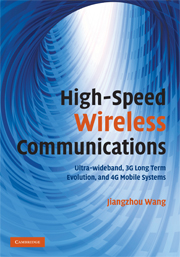Book contents
- Frontmatter
- Contents
- Preface
- Acknowledgements
- List of abbreviations
- Part I Introduction
- Part II UWB communications
- Part III Evolved 3G mobile communications
- 5 TD Receiver with ideal channel state information
- 6 TD receiver with imperfect channel estimation
- 7 QAM with antenna diversity
- 8 QAM for multicode CDMA with interference cancellation
- Part IV 4G mobile communications
- Index
- References
7 - QAM with antenna diversity
from Part III - Evolved 3G mobile communications
Published online by Cambridge University Press: 27 May 2010
- Frontmatter
- Contents
- Preface
- Acknowledgements
- List of abbreviations
- Part I Introduction
- Part II UWB communications
- Part III Evolved 3G mobile communications
- 5 TD Receiver with ideal channel state information
- 6 TD receiver with imperfect channel estimation
- 7 QAM with antenna diversity
- 8 QAM for multicode CDMA with interference cancellation
- Part IV 4G mobile communications
- Index
- References
Summary
The coherent MRC reception of PSAM MQAM systems with antenna diversity is studied in this chapter. A general fast time varying fading channel model is assumed. Pilot symbols are periodically inserted during the transmission of data symbols, which are used to track the time varying fading, and to provide channel estimation for data decisions at the receiver. Based on a digital implementation, a coherent demodulation scheme is presented. Channel estimation error due to fast fading and additive noise is studied. System performance is evaluated in terms of BER. The analysis shows that in perfect channel estimation cases, with the antenna diversity technique, the BER performance improves significantly, and higher-order QAM can be employed for higher throughput. It is also found that inaccurate channel estimation limits the benefit of diversity when the modulation order is large. By increasing the length of the channel estimator and the amplitude of the pilot symbol, more accurate channel estimation can be achieved, so that the BER performance is improved. Moreover, when the Doppler frequency is less than 1 / 2ST, where S is the number of symbols per time slot and T is the symbol duration, the performance is flat since the channel estimator is robust to fading rate.
Introduction
During the past several decades, MQAM has been considered for high rate data transmission over wireless links due to its high spectral efficiency [1–4].
- Type
- Chapter
- Information
- High-Speed Wireless CommunicationsUltra-wideband, 3G Long Term Evolution, and 4G Mobile Systems, pp. 198 - 213Publisher: Cambridge University PressPrint publication year: 2008



